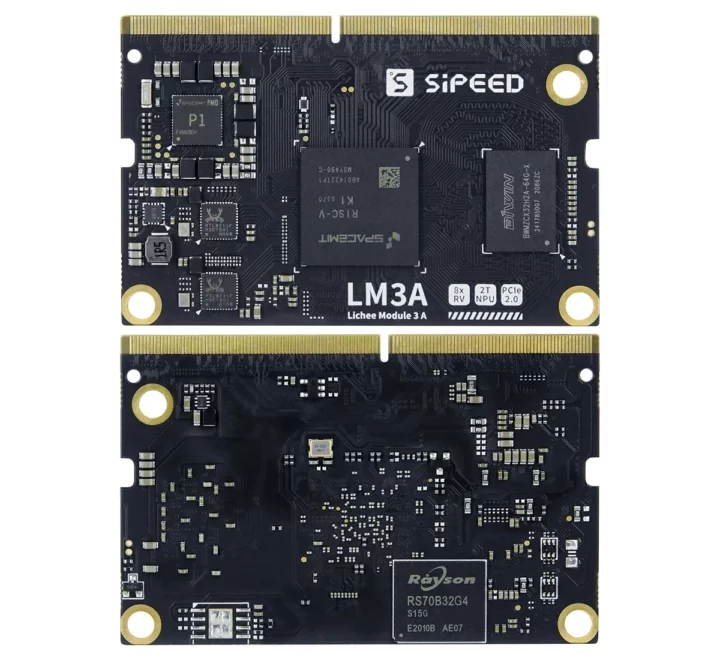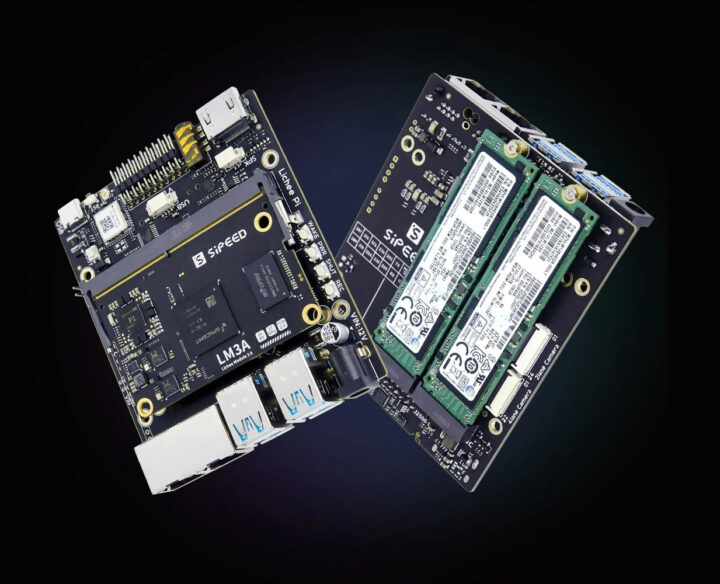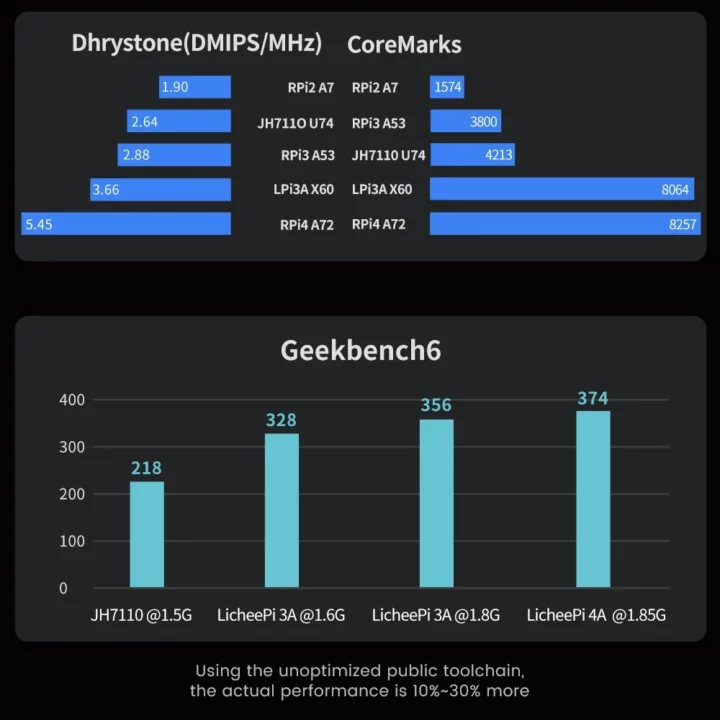Sipeed LicheePi 3A is a development board comprised of the LM3A system-on-module based on SpacemIT K1 octa-core RISC-V SoC and the same baseboard as found in the earlier LicheePi 4A equipped with a T-Head TH1520 quad-core RISC-V “LM4A” system-on-module instead.
The LicheePi 3A is currently offered with a 32GB eMMC flash and 8GB or 16GB LPDDR4x memory. The carrier board provides a microSD card, two M.2 PCIe sockets for storage or other expansion, two gigabit Ethernet ports, a WiFi 6 and Bluetooth 5.2 module, HDMI and MIPI DSI display interfaces, two MIPI CSI camera interfaces, four USB 3.0 ports, and a 20-pin GPIO header for expansion.
Sipeed LicheePi 3A specifications:
- Sipeed LM3A SoM
- SoC – SpacemiT K1
- CPU – 8-core X60 RISC-V processor @ 1.6 GHz
- GPU – Imagination IMG BXE-2-32 with support for OpenGL ES3.2, Vulkan 1.2, OpenCL 3.0; 20 GFLOPS
- VPU – H.265 and H.264 1080p60 decoding/encoding
- NPU – 2.0 TOPS (INT8) AI accelerator
- RVA 22 Profile RVV 1.0 compliant
- System Memory – 8GB or 16GB 32bit LPDDR4X-2400
- Storage – 32GB eMMC flash
- Networking – 2x Realtek RTL8211F gigabit Ethernet transceivers
- SoC – SpacemiT K1
- Storage
- MicroSD card slot
- 2x M.2 PCIe 2.0 x2 sockets for 2280 NVMe SSDs
- Video Output
- HDMI 1.4 port up to 1080p60
- 4-lane MIPI DSI connector up to 1080p60
- Camera I/F
- 4-lane MIPI CSI connector up to 4K @ 60fps
- 2-lane MIPI CSI connector
- Audio
- 3.5mm headphone jack
- 2-pin speaker connector
- Networking
- 2x gigabit Ethernet RJ45 ports
- WiFi 6 and Bluetooth 5.x wireless module
- USB
- 4x USB 3.0 Type-A ports
- 1x USB 2.0 Type-C port
- Expansion – 20-pin GPIO header with UART, I2C, SPI, etc.
- Power Supply
- 12V via DC jack
- 5V via USB-C port
- Optional PoE support
- Dimensions – TBD

Sipeed provides Ubuntu-based Bianbu optimized for RISC-V targets, Fedora, Deepin, and openKylin images for the LM3A module and LicheePi 3A board which you’ll find on the documentation website. Last month, I tested Bianbu OS on the Jupiter mini-ITX motherboard powered by the same SpacemIT K1/M1 SoC. I noticed some progress over my previous experience with RISC-V Linux boards, including working 3D graphics acceleration. However, there were still more work to do as YouTube video playback would only sort of work at 480p max, several USB storage devices could be not detected, and a PCIe graphics card could be detected, but was not working yet as more work needed to be done on the software side.
Since the LicheePi 3A development board simply replaces an LM4A CPU module with an LM3A, all accessories for the LicheePi 4A also work with the SpacemIT K1 board including the metal enclosure, 10.1-inch display, PoE add-on board, camera module and other accessories.
Performance-wise, the LicheePi 3A can about match Raspberry Pi 4 performance in CoreMarks, but only because it has eight cores, and it’s a little slower in Geekbench6 (multi-core) compared to the earlier LicheePi 4A according to the benchmark charts above shared by Sipeed. The company further states that the multi-core performance is about 80% of the LM4A and the single-core performance is around 50% as fast. The main benefit of the SpacemIT K1 development board is that it is more affordable.
Sipeed has started to sell the LicheePi 3A board on AliExpress for $99 in 8GB/32GB configuration, and $158 in 16GB/32GB configuration. Just like with the earlier LM4A CPU module, the LM3A will be integrated into a range of devices including the Lichee Console 3A mini terminal computer, Lichee Cluster 3A with up to seven LM3A modules, and the Lichee Book 3A laptop with a 14-inch display. Additional information may be found on the product page.

Jean-Luc started CNX Software in 2010 as a part-time endeavor, before quitting his job as a software engineering manager, and starting to write daily news, and reviews full time later in 2011.
Support CNX Software! Donate via cryptocurrencies, become a Patron on Patreon, or purchase goods on Amazon or Aliexpress






